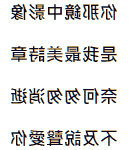Cantonese love poem
鏡
你那鏡中影像
是我最美詩章
奈何匆匆消逝
不及說聲愛你
Thanks to Alice Moulimois (Education University of Hong Kong)

In Cantonese Jyutping
Geng3
nei5 naa5 geng3 zung1 jing2 zoeng6
si6 ngo5 zeoi3 mei5 si1 zoeng1
noi6 ho4 cung1 cung1 siu1 sai6
bat1 kap6 syut3 seng1 oi3 nei5
Another version
鏡
你系镜入边噶反射,
系硪最靓噶诗篇,
但系锦快就消失佐,
果个系硪最后噶:硪爱你
In Cantonese pinyin
Géng
néih hàih géng jàhp bìn gàa fàan jèh
hàih ngo zéoi léng gàa sì pìn
dàahn hàih gām fáai zàuh sìu sàt zó
gū gó hàih ngo zéoi hàuh gàa: ngo ngói néih

→ French poem ←
Explanations
Here is the Cantonese (Hong Kong) translation of my poem in the literary form, popular in Hong Kong, written in Chinese (vernacular). This translation is followed by one of the possible forms of the romanization, here, that of the Linguistic Society of Hong Kong, founded in 1986, and which dates from 1993.
Bernard, who made the audio recording, preferred to the written translation he had produced, this of his friend Wong Chi-kuen, who is also from Hong Kong. He pointed out to me that this is a translation as much as a poem by its own right, which precisely caught the spirit and emotions of the original: the longing regret left from a glimpse of adoration, as my friend put it aptly in a Chinese idiom: 驚鴻 一瞥, a frightened swan goose flew right past one’s sight, leaving an image for life.
Cantonese
The love poem translated into Cantonese (yue), written as it should be in sinograms. This Chinese language, from Guangdong, Guangxi, Macao and Hong Kong, has about 60 million speakers.
More conservative than other dialects, the Chinese Yue keeps most of the final consonants and a system of 6 tones (unlike the 4 Chinese standard tones). The language spoken in Canton is also the language of Hong Kong and Macao and that of most Chinese immigrants scattered throughout the world.
Chinese languages can be quite similar to the written word because of the writing system of the sinograms. The traditional characters, still used in Hong Kong, Taiwan and Macao, have been simplified in the people's republic, sometimes beyond recognition. In Hong Kong for example, there are 200 non-standard characters to represent Cantonese words. As a result of these differences, mainland mandarin speakers may have difficulty reading a Hong Kong newspaper.
The relationship between Cantonese and Mandarin Chinese in Hong Kong is akin to that of Swiss German and High German in Switzerland: the former exists mostly as the spoken, informal, layman language while the latter as the written, formal, literary language, despite one can still technically read and write in both. Therefore, it is the linguistic convention to read aloud a written Chinese article in Cantonese.